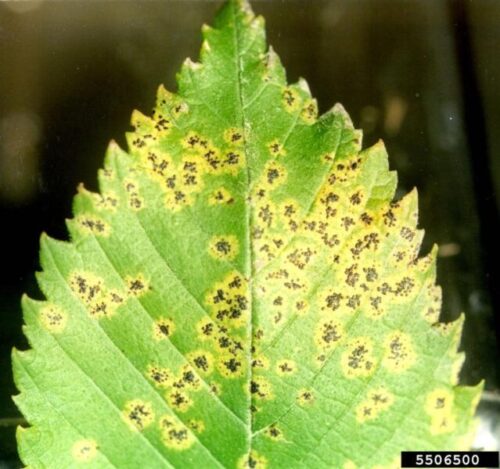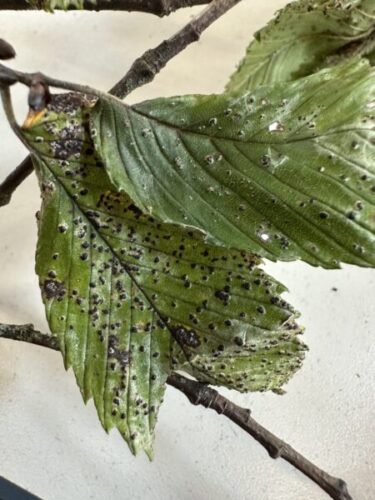 Purdue University - Extension - Forestry and Natural Resources
Purdue University - Extension - Forestry and Natural Resources
Got Nature? Blog
Purdue Landscape Report: We have received a few elm tree samples this year with a disease we do not often see, but which is relatively common: black spot of elm. This disease, also called elm anthracnose, is caused by the fungus Stegophora ulmea and can affect most species of elm with American elm varieties being more susceptible.

Figure 1. Elm foliage with chlorotic spotting and black fungal structures caused by Stegophora ulmea.
The fungus becomes active in the spring at temperatures of 45 deg F or above. It can release spores that will infect newly unfolding leaves leading to chlorotic leaf spots or blotches on the upper leaf surface. Black fungal fruiting bodies will develop within the affected tissue, making it seem like the leaves have been dotted with tar. These fungal structures are raised and will give the leaf a bumpy texture. As more spots develop and coalesce, they will create white areas of dead tissue that can eventually turn brown.
The black fungal stromata can produce asexual spores (conidia) which can cause new infections during the growing season. Conidia are produced in a mucilage which becomes loose in humid conditions and can be spread by water splash (rain or irrigation). While leaf infections are the most commonly observed symptom, Stegophora can also infect leaf petioles and twigs. Premature leaf drop due to severe leaf spotting can occur, but significant defoliation may also develop when petioles are infected. Stem infections can lead to shoot blighting and small limb dieback.
Black spot is generally worse when the weather is cool and moist over an extended period of time. The fungus can reinfect the tree throughout the season during rainy. When the summer turns hot and dry, disease development will slow down and trees with twig blighting may show some recovery by pushing out new growth from dormant buds below affected shoots. Please note that twig blighting may look similar to flagging branches associated with Dutch elm disease (DED), so we recommend pruning off the branch and looking for internal vascular streaking to rule out DED.
Fungicides are not normally recommended to manage this disease for mature trees in landscapes since it is impractical to get full coverage of the foliage and damage is not usually severe. However, preventative applications may be warranted in nursery settings when the disease is severe to protect new growth and slow down disease spread until drier weather occurs, especially where overhead irrigation is used. Raking up leaf litter and pruning out infected stems will remove inoculum for the following season and help prevent existing infections from spreading.
Click here for more information on Dutch elm disease and view this original article here: A New Threat to Elms in North America
Subscribe and receive the newsletter: Purdue Landscape Report Newsletter.
Resources:
Intro to Trees of Indiana: American Elm, Got Nature? Blog, Purdue Extension – FNR
Intro to Trees of Indiana: Slippery Elm, Got Nature? Blog, Purdue Extension – FNR
ID That Tree, Playlist, Red Elm, Siberian Elm, Winged Elm, Purdue Extension – Forestry and Natural Resources (FNR) YouTube Channel
Invasive Species Playlist, Playlist, Purdue Extension – FNR YouTube Channel
A Woodland Management Moment, Playlist, Purdue Extension – FNR YouTube Channel
Woodland Stewardship for Landowners, Playlist, Purdue Extension – FNR YouTube Channel
Indiana Department of Natural Resources: Invasive Species
Indiana Invasive Species Council
Cooperative Invasive Species Management Area (CISMA)
Report Invasive, Purdue Extension
Episode 11 – Exploring the challenges of Invasive Species, Habitat University-Natural Resource University
What are invasive species and why should I care?, Got Nature? Blog, Purdue Extension – FNR
Native Trees of the Midwest, The Education Store
Investing in Indiana Woodlands, The Education Store
Forest Improvement Handbook, The Education Store
John Bonkowski, Lead Extension Administrator
Purdue Department of Botany and Plant Pathology

Recent Posts
- Smooth Patch of Oak – Purdue Landscape Report
Posted: March 27, 2025 in Forests and Street Trees, Urban Forestry, Wildlife, Woodlands - Prepared for Insects Waking Up? – PLR
Posted: March 26, 2025 in Forestry, Invasive Insects, Urban Forestry, Wildlife - ID That Tree: Invasive Autumn Olive
Posted: March 24, 2025 in Forestry, Invasive Plant Species, Urban Forestry, Wildlife, Woodlands - PPDL’s 2024 Annual Report – Enhancing Plant Health
Posted: March 21, 2025 in Forestry, Invasive Insects, Invasive Plant Species, Plants, Wildlife - Rays Sharing Their Award Winning Forest – Oak Management Forestry Field Day
Posted: March 20, 2025 in Forestry, How To, Invasive Plant Species, Wildlife, Woodlands - New Directory of Professional Foresters Now Available for Indiana Woodland Owners
Posted: March 19, 2025 in Forestry, How To, Woodlands - Planting the Future: Arbor Day Seedlings for Third Graders – IN DNR
Posted: March 18, 2025 in Community Development, Forestry, Woodlands - ID That Tree: Greenbrier
Posted: March 12, 2025 in Forestry, Urban Forestry, Woodland Management Moment - Help the Hellbenders Wins Friends of Conservation Award
Posted: March 7, 2025 in Forestry, Wildlife, Woodlands - Publication – Direct Marketing Guidebook for Small/Medium-Scale Aquaculture Businesses
Posted: in Aquaculture/Fish, Aquatic/Aquaculture Resources, Publication
Archives
Categories
- Alert
- Aquaculture/Fish
- Aquatic/Aquaculture Resources
- Ask the Expert
- Christmas Trees
- Community Development
- Disease
- Drought
- Forestry
- Forests and Street Trees
- Gardening
- Got Nature for Kids
- Great Lakes
- How To
- Invasive Animal Species
- Invasive Insects
- Invasive Plant Species
- Land Use
- Natural Resource Planning
- Nature of Teaching
- Plants
- Podcasts
- Ponds
- Publication
- Safety
- Spiders
- Timber Marketing
- Uncategorized
- Urban Forestry
- Webinar
- Wildlife
- Wood Products/Manufacturing
- Woodland Management Moment
- Woodlands
